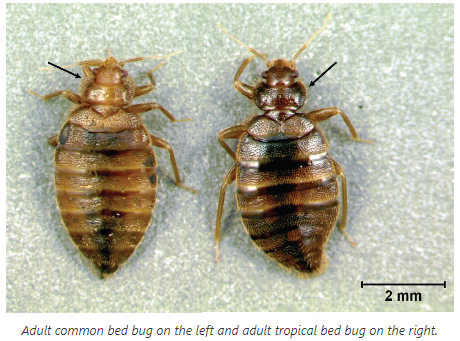Bed bugs are tiny, brown, oval insects that often hide under linens and feed on your blood. They are a great nuisance and they have become a huge problem especially in the United States of America. These insects also lay several of eggs at a time and unlike most insects, they do not fly but instead, they crawl.
Well, the information above covers some basics but they don’t even scratch the surface. There is more to bed bugs that you ought to know to be able to avoid or deal with them appropriately. This post compiles a list of some surprising facts about bed bugs that you will not find on the news.
Table of Contents
Two species of bed bugs are spreading across the world
When someone mentions bed bugs, most of us assume that there is one species worldwide. That assumption is inaccurate because there are two species of bed bugs spreading across the world. These species include the tropical bed bugs (Cimex hemipterus) and the common bed bugs (Cimex lectularias).
Both species feed on human blood and their bites elicit similar reactions; itchy skin and rashes. They also have similar behaviors such as hiding in cracks and linen. A tropical bed bug infestation would appear similar to a common bed bug infestation. That said, research shows that tropical bed bugs are more resilient to different extermination methods including high temperatures.
Tropical bed bugs are common in hot regions including Asia, Africa and South America. The common bed bug is the most predominant species in the USA with reports of its presence across all 50 states. If you live in the State of Florida, however, you should watch out for tropical bed bugs.
To the untrained eye, both bed bug species look identical. You will even notice similar signs of bed bugs if you visit a space infested by any of them. Upon a closer look using a microscope or a lens, you will notice some tell-tale difference which is;
- The common bed bug has a u-shaped pronotum or ‘neck’.
- The tropical bed bug, on the other hand, has a narrower and less pronounced neck shape.
Drinking a glass of wine can help reduce bed bug bites
According to a research report from the University of Nebraska, bed bugs tend to shy away from intoxicated hosts. This means that a few glasses of alcohol may reduce the number of bites when sleeping in an infested space.
Nevertheless, you should not consider alcohol as a method of pest control because of the negative implications of alcohol consumption and because it will not help stop an existing infestation.
You may not notice bed bug bites for up to two weeks
Unlike most insects, bed bugs have developed an interesting evolutionary characteristic. They anesthetize the area they intend to bite before they suck your blood. Thus, you will not feel any discomfort or pain when they bite through you skin. It is also worth noting that some people’s skins do not react to bed bug bites at all. That said, here are some reactions to bites that you should expect;
- Bites can elicit reddish spots on the skin and itchiness
- Lamps can appear on your skin in a line or no distinct pattern
- Some people can develop allergies which are often not life threatening
Bed bugs can consume seven times their body weight in blood
Most of us assume that bed bugs do not consume much blood considering that they are tiny. The fact, however, is that they can consume up to seven times their body weight in blood. The thought of losing that much blood is scary.
Bed bugs have sharp instincts compared to most insects
Unlike humans, bed bugs do not have creative problem solving capabilities, but have incredible instincts. This is one of the reasons you will rarely come across a bed bug during the day even if your space is severely infested. Their strong instincts allow them to resist the temptation of food at daytime when you can easily spot them.
They only come out when the smell of carbon dioxide is too powerful to resist. This happens at night when you are sleeping. People tend to exhale a lot in their sleep.
Bed bugs are selective about their food
We all know that bed bugs feed on human blood. They, however, only feed on warm, fresh blood direct from a live host. Unlike cockroaches that feed on anything in their path, bed bugs settle on only the best. They do not fall into the temptation of cold or spilled blood.
Bed bugs can resist traditional fumigation methods
According to a recent study published in the journal of economic entomology, traditional fumigation methods and chemicals are no longer effective. Bed bugs have recently developed a strong resistance to various insecticides thus, making it hard to kill them using chemicals only. In light of this new development, it is advisable to combine different bed bug extermination methods such as heat treatment.
Bed bugs are methodical feeders
Most people have a predictive pattern of meals namely, breakfast, lunch and dinner. The same can be said about bed bugs. These pesky insects have a probable feeding pattern. Once they find their hosts, they usually suck blood for 5 to 10 minutes until repletion.
The average cost of exterminating bed bugs is high
Bed bugs are more expensive to exterminate than most pests. If you uncover infestation that you have to deal with, you must be ready to spend some serious cash. The average cost of bed bug removal services in the US ranges from $1000 to $2500. That said, you must note that the cost of extermination is dependent on several factors including;
- The degree of infestation
- The size of the infested space
- The number of areas that appear to be infested
- Choice of extermination service provider
Bed bugs reproduce swiftly
Bed bug infestations grow at an exponential pace. A single female bed bugs can lay up to 250 eggs in her lifespan which lasts approximately three to four months. This reproduction speed is slower that other insects but it is still a course for concern. Thus, it is best to deal with an infestation as fast possible so that you can have a good night’s sleep.
Bed bugs can live for up to a year without eating
Some people may decide to store contaminated belongings in storage hoping that the bed bugs will die out of hunger. You can rest assured that this plan will not work because bed bugs can survive for up to one year without any food.
If you notice the signs of a bed bugs infestation, you should use the techniques to get rid of bed bugs permanently.
Regina Gries has let 20,000 bed bugs bite her for research purposes
Have you ever asked yourself what it takes to develop effective bed bug traps? Well, it takes a lot of sacrifice and effort to develop a dependable pheromone trap. While working on developing a pheromone trap, Regina Gries, a biologist at Simon Fraser University has let 20,000 bed bugs bite her. This is pretty astonishing considering that most people dread the thought of bed bugs, right?
Mattress protectors are no match for bed bugs
Considering that bed bugs often hide on mattress linings, most people assume that mattress protectors can shield them against bed bugs. That is far from the truth. Such protectors only shield them mattress.
There are several areas where bed bugs can hide on your bed. High risk sections of the bed include headboards, box springs, and cracks on the bed frame. To keep bed bugs away from your space, here are some things you need to do:
- Be cautious about second hand items such as furniture, books and clothing.
- Vacuum your house regularly.
- Spray bed bug-repelling essential oils such as Peppermint on various belongings such as the mattress, beddings and clothing.
- You can also place black walnut tea bags on areas with high risk of infestations.
Final Thoughts
There are several facts about bed bugs that you should know in order to deal with them effectively. Visit our page to regularly to explore more interesting facts because we shall continue to update you on emerging interesting facts about these pestilent critter.


